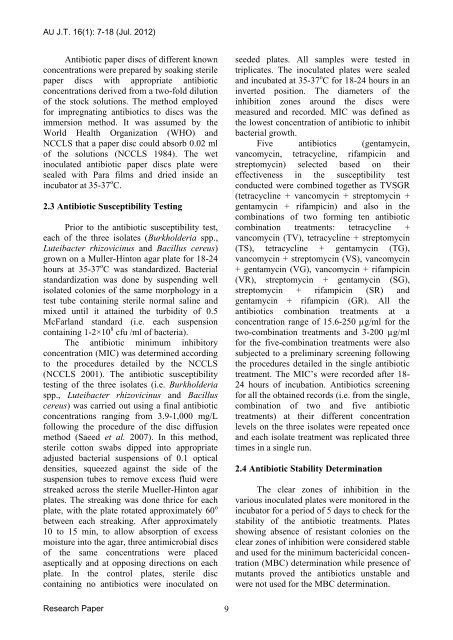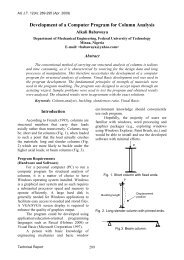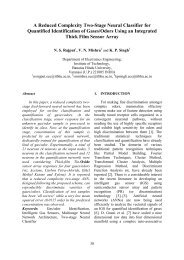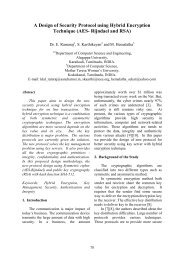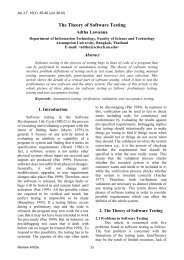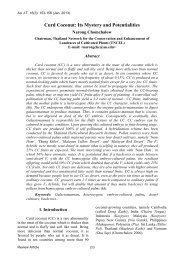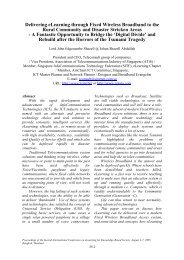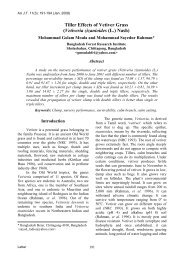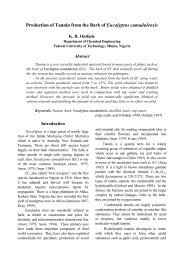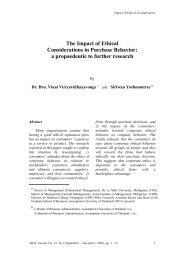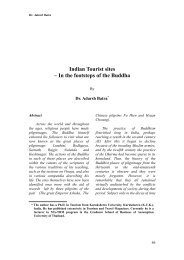Screening Antibiotics for the Elimination of Bacteria ... - AU Journal
Screening Antibiotics for the Elimination of Bacteria ... - AU Journal
Screening Antibiotics for the Elimination of Bacteria ... - AU Journal
You also want an ePaper? Increase the reach of your titles
YUMPU automatically turns print PDFs into web optimized ePapers that Google loves.
<strong>AU</strong> J.T. 16(1): 7-18 (Jul. 2012)<br />
Antibiotic paper discs <strong>of</strong> different known<br />
concentrations were prepared by soaking sterile<br />
paper discs with appropriate antibiotic<br />
concentrations derived from a two-fold dilution<br />
<strong>of</strong> <strong>the</strong> stock solutions. The method employed<br />
<strong>for</strong> impregnating antibiotics to discs was <strong>the</strong><br />
immersion method. It was assumed by <strong>the</strong><br />
World Health Organization (WHO) and<br />
NCCLS that a paper disc could absorb 0.02 ml<br />
<strong>of</strong> <strong>the</strong> solutions (NCCLS 1984). The wet<br />
inoculated antibiotic paper discs plate were<br />
sealed with Para films and dried inside an<br />
incubator at 35-37 o C.<br />
2.3 Antibiotic Susceptibility Testing<br />
Prior to <strong>the</strong> antibiotic susceptibility test,<br />
each <strong>of</strong> <strong>the</strong> three isolates (Burkholderia spp.,<br />
Luteibacter rhizovicinus and Bacillus cereus)<br />
grown on a Muller-Hinton agar plate <strong>for</strong> 18-24<br />
hours at 35-37 o C was standardized. <strong>Bacteria</strong>l<br />
standardization was done by suspending well<br />
isolated colonies <strong>of</strong> <strong>the</strong> same morphology in a<br />
test tube containing sterile normal saline and<br />
mixed until it attained <strong>the</strong> turbidity <strong>of</strong> 0.5<br />
McFarland standard (i.e. each suspension<br />
containing 1-2×10 8 cfu /ml <strong>of</strong> bacteria).<br />
The antibiotic minimum inhibitory<br />
concentration (MIC) was determined according<br />
to <strong>the</strong> procedures detailed by <strong>the</strong> NCCLS<br />
(NCCLS 2001). The antibiotic susceptibility<br />
testing <strong>of</strong> <strong>the</strong> three isolates (i.e. Burkholderia<br />
spp., Luteibacter rhizovicinus and Bacillus<br />
cereus) was carried out using a final antibiotic<br />
concentrations ranging from 3.9-1,000 mg/L<br />
following <strong>the</strong> procedure <strong>of</strong> <strong>the</strong> disc diffusion<br />
method (Saeed et al. 2007). In this method,<br />
sterile cotton swabs dipped into appropriate<br />
adjusted bacterial suspensions <strong>of</strong> 0.1 optical<br />
densities, squeezed against <strong>the</strong> side <strong>of</strong> <strong>the</strong><br />
suspension tubes to remove excess fluid were<br />
streaked across <strong>the</strong> sterile Mueller-Hinton agar<br />
plates. The streaking was done thrice <strong>for</strong> each<br />
plate, with <strong>the</strong> plate rotated approximately 60 o<br />
between each streaking. After approximately<br />
10 to 15 min, to allow absorption <strong>of</strong> excess<br />
moisture into <strong>the</strong> agar, three antimicrobial discs<br />
<strong>of</strong> <strong>the</strong> same concentrations were placed<br />
aseptically and at opposing directions on each<br />
plate. In <strong>the</strong> control plates, sterile disc<br />
containing no antibiotics were inoculated on<br />
seeded plates. All samples were tested in<br />
triplicates. The inoculated plates were sealed<br />
and incubated at 35-37 o C <strong>for</strong> 18-24 hours in an<br />
inverted position. The diameters <strong>of</strong> <strong>the</strong><br />
inhibition zones around <strong>the</strong> discs were<br />
measured and recorded. MIC was defined as<br />
<strong>the</strong> lowest concentration <strong>of</strong> antibiotic to inhibit<br />
bacterial growth.<br />
Five antibiotics (gentamycin,<br />
vancomycin, tetracycline, rifampicin and<br />
streptomycin) selected based on <strong>the</strong>ir<br />
effectiveness in <strong>the</strong> susceptibility test<br />
conducted were combined toge<strong>the</strong>r as TVSGR<br />
(tetracycline + vancomycin + streptomycin +<br />
gentamycin + rifampicin) and also in <strong>the</strong><br />
combinations <strong>of</strong> two <strong>for</strong>ming ten antibiotic<br />
combination treatments: tetracycline +<br />
vancomycin (TV), tetracycline + streptomycin<br />
(TS), tetracycline + gentamycin (TG),<br />
vancomycin + streptomycin (VS), vancomycin<br />
+ gentamycin (VG), vancomycin + rifampicin<br />
(VR), streptomycin + gentamycin (SG),<br />
streptomycin + rifampicin (SR) and<br />
gentamycin + rifampicin (GR). All <strong>the</strong><br />
antibiotics combination treatments at a<br />
concentration range <strong>of</strong> 15.6-250 µg/ml <strong>for</strong> <strong>the</strong><br />
two-combination treatments and 3-200 µg/ml<br />
<strong>for</strong> <strong>the</strong> five-combination treatments were also<br />
subjected to a preliminary screening following<br />
<strong>the</strong> procedures detailed in <strong>the</strong> single antibiotic<br />
treatment. The MIC’s were recorded after 18-<br />
24 hours <strong>of</strong> incubation. <strong>Antibiotics</strong> screening<br />
<strong>for</strong> all <strong>the</strong> obtained records (i.e. from <strong>the</strong> single,<br />
combination <strong>of</strong> two and five antibiotic<br />
treatments) at <strong>the</strong>ir different concentration<br />
levels on <strong>the</strong> three isolates were repeated once<br />
and each isolate treatment was replicated three<br />
times in a single run.<br />
2.4 Antibiotic Stability Determination<br />
The clear zones <strong>of</strong> inhibition in <strong>the</strong><br />
various inoculated plates were monitored in <strong>the</strong><br />
incubator <strong>for</strong> a period <strong>of</strong> 5 days to check <strong>for</strong> <strong>the</strong><br />
stability <strong>of</strong> <strong>the</strong> antibiotic treatments. Plates<br />
showing absence <strong>of</strong> resistant colonies on <strong>the</strong><br />
clear zones <strong>of</strong> inhibition were considered stable<br />
and used <strong>for</strong> <strong>the</strong> minimum bactericidal concentration<br />
(MBC) determination while presence <strong>of</strong><br />
mutants proved <strong>the</strong> antibiotics unstable and<br />
were not used <strong>for</strong> <strong>the</strong> MBC determination.<br />
Research Paper 9


